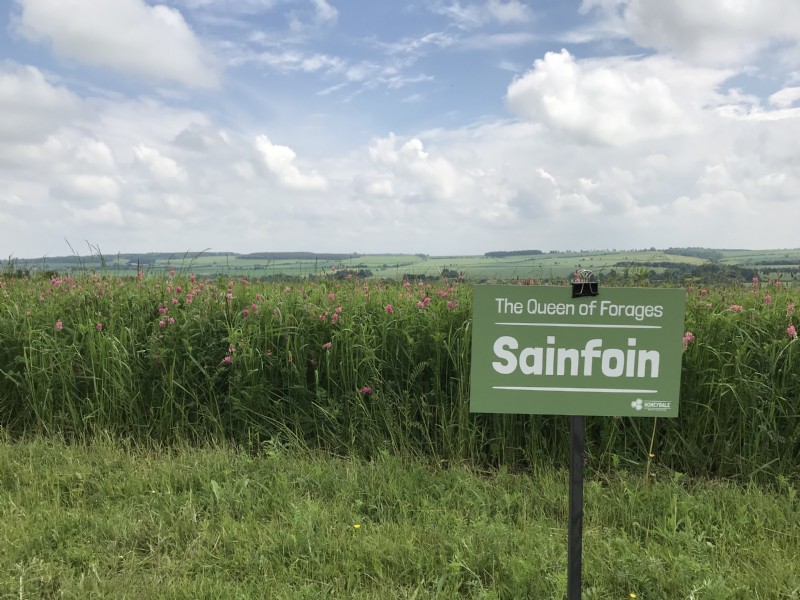

The Sainfoin Experience Day was hosted by Cotswold Seeds and the University of Reading, to discover more about the many benefits this ‘Healthy Hay’.
Full presentations are available to watch below.
Professor Irene Mueller-Harvey
The keynote speech was given by Professor Irene Mueller-Harvey, who looked at findings from EU projects, with a focus on parasitology, soil health and structure.
She explained the importance of bioactive tannins, what they are, and how they improve soil fertility, drought resistance and animal health/parasite control.
Highlights of the findings she presented included how, when sainfoin was grown together with grasses, there were less weeds in the field, the overall mass of the yield was higher, and the nutritive value of the mixture was better.
Looking at anthelmintic drugs vs tannins, Professor Mueller-Harvey explained how worm populations are becoming resistant to the three main classes of anthelmintic drugs, leaving some farmers in the USA and Africa unable to keep any animals on their farms. ‘Tannins are not as effective as drugs,’ Professor Mueller-Harvey explained.’ They don’t kill 99.9% of parasites, but they can interfere with the parasitic life cycle at every stage. They reduce the overall number of parasites so the animals can generate their own immune system.’
Professor Mueller-Harvey also talks about how a study with calves in Denmark showed how parasite numbers were reduced by feeding them sainfoin pellets. The worms shrivelled up and the sainfoin blocked orifices so the worms could no longer feed or reproduce.
Sokratis Stergiardis
Sokratis Stergiardis gave a presentation on the ongoing research at UoR, the nutritional benefits of sainfoin and high tannin forage crops.
He said that put simply, ‘the focus is how to make livestock make the most of the protein we feed them.’
He looked at how the way ruminants are fed can improve omega 3 content and the quality of milk and meat, reduce methane emissions from ruminant farms, and reduce nitrogen output in urine.
He described the feeding trials of different silage in growing lambs in France and at the effects, on milk and meat quality, of dried pellets fed to dairy cows. Saturated fat content is the main concern linked to cardiovascular disease in humans and research looked at producing milk with less saturated fat content and more unsaturated and polyunsaturated fats. A study from the Netherlands showed that cows which consumed sainfoin produced milk with more polyunsaturated fatty acids and trials of silage fed to lambs in Switzerland also produced meat with more omega 3 fatty acids.
Dr Lydia Smith
Dr Lydia Smith from Innovation Farm’s presentation included the anthelmintic properties of sainfoin and how it improves soil microbiology.
She looked at sainfoin varieties and accessions, the difference in tannin content, biochemistry, foliage shapes, thickness of stem and the impacts of this. For instance, The Cambridge Common has a taller and thicker stem so lends itself to haylage. She also looked at germination and the need to plant fresh seeds. Finally Dr Lydia Smith turned her attention to herbicide trials and companion trials for weed control, comparing traditional companion crops - Spring Barley and Timothy - to others, such as chicory, beans and oats, with positive results.
Pascale Gombault
Pascale Gombault, from the Multiflora Consortium, looked at a new model of legume production. After introducing the history of Sainfoin in France she talked about how the Multifolia Consortium has perfected a method of dehydrating sainfoin into pellets to improve the tannin concentration and make it easier to transport and mix. It has many applications: agronomy, animal health, arable health, biodiversity, and environmental. The pellets are now in demand from livestock breeders and a new model has shown the benefits for beekeepers.
Henry Edmunds
Farmer Henry Edmunds shared his great enthusiasm, knowledge and experiences of growing sainfoin with much success over many years.
Henry Edmunds believes it’s a ‘national scandal’ that sainfoin has been ignored for so many years. He explains how it’s ‘not difficult to establish if basic principles are adhered to’ and gives a high productivity for ten years or more with no weed control necessary. He gives practical advice for growers and talks about how cultivation of sainfoin ‘has faded away with the loss of mixed farming and the hegemony of the arable sector, but today we are confronted with new challenges, the dependency on agrichemicals and declining soil health.’
Date Posted: 5th July 2018



